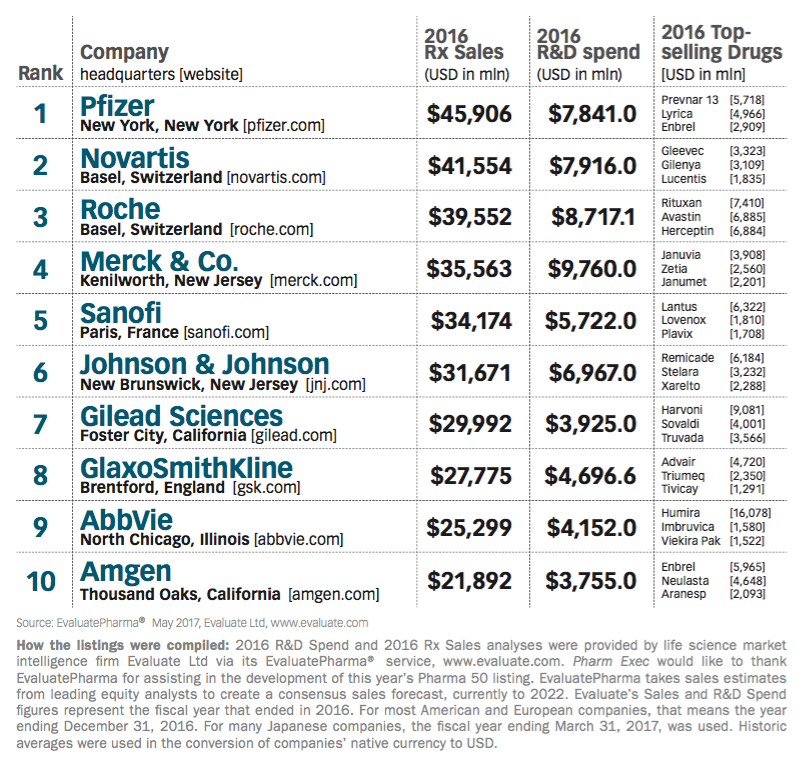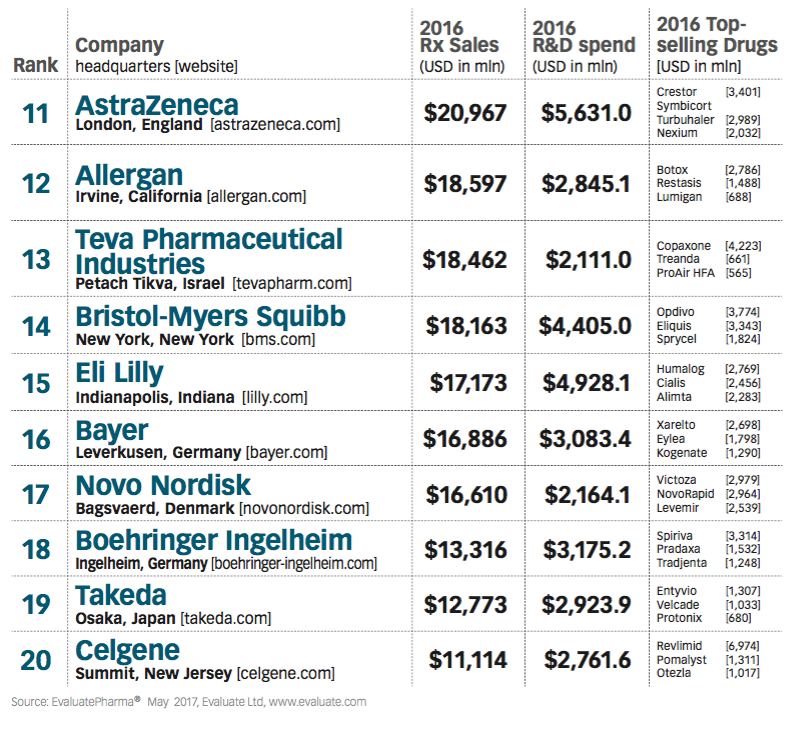Pharm Exec's Top 50 Companies 2017
Pharm Exec's 17th annual listing of the top biopharma players paints a stable picture of performance for the usual placeholders, but change and disruption to current business models could upend positioning in the years ahead.
Pharm Exec's latest annual listing of the top biopharma players paints a stable picture of performance for the usual placeholders, but change and disruption to current business models could upend positioning in the years ahead.
With the exception of a few new bottom-end entrants, and some juggling of positions in the top half, stability remains the name of the game for those biopharmaceutical companies making up this year’s list of the industry’s top 50 global sales leaders (see tables below). Of course, the relative calm in the rankings meter doesn’t mean that stability necessarily begets profitability for all. Amid growing pricing pressures, key patent losses for some, and a slowdown in M&A activity since the middle of 2016, several mainstays on the Pharma 50 list experienced only modest revenue gains in the latest full-year figures collected, while others suffered slight declines. Pharm Exec’s 17th annual listing again features data provided by biopharma market intelligence firm Evaluate Ltd.
Experts attribute the consistent entrenchment of familiar names in the top 10 and 20 to the simple adage of “how business gets done” in this industry-mainly big pharma following a model that continues to prioritize amassing products and innovation through internal R&D, licensing, or acquisition. Pfizer, for example, which repeated as the industry’s prescription sales leader, has maintained its hold by applying the latter two. As have companies such as Shire, which spurred by its completed merger of Baxalta in June 2016, shot up from the 30th spot to No. 22 on this year’s revenues list. And on the R&D side, Shire’s investment increased 45.5% to $1.29 billion.
Merck & Co., despite being ranked fourth in sales, is No. 1 in R&D spend, with a 47.6% spike in investment versus the previous year. The company’s newest rising seller, the immunotherapy Keytruda, continues to be studied across numerous tumor types, lines of therapy, and combinations. Others that didn’t climb the sales ranks but are investing solidly in R&D include Lilly (15th in sales, eighth in R&D spend) and AstraZeneca (11th in sales, seventh in R&D).
As far as future shifts in sales-figure positioning in the Pharma 50, Jonathan Gardner, EP Vantage News Editor, US, at Evaluate, cites two areas to watch. “The first is pricing, to the extent where payers become more assertive in areas where they have been reluctant in the past, such as oncology or orphan diseases,” Gardner tells Pharm Exec. “On the latter, we’ve seen payers be surprisingly skeptical of new drugs Spinraza and Exondys 51, and there is potential for that to expand. The second issue is disease areas that have become crowded with new agents-autoimmune disorders such as psoriasis and rheumatoid arthritis-that could give payers even more leverage than they’ve had in the past on franchises such as Humira and Enbrel.”
Gardner also notes that until the outlook on US pricing legislation, tax reform, and repeal and replace of the Affordable Care Act becomes clearer, a big rush on M&A is unlikely. “Opportunistic deals will appear, but companies with significant amounts of overseas cash will be reluctant to risk overpaying on taxes to execute major US acquisitions,” he says. “Pricing and ACA repeal/replace pose similar, if lower-level risks.”
Which leads us to our special Pharma 50 accompanying feature by guest authors at the executive search and talent advisory firm Russell Reynolds Associates. The authors contend that a significant disruptive event looms on the horizon for the industry, brought on by new US legislation on pricing and new definitions of value. The article points out that traditional sourcing routes for biopharma innovation-in-licensing, M&A, and R&D collaboration-have been expanded by new models of engagement with external innovators, such as open innovation models and corporate ventures. Managing the diversity and complexity of these innovations, and building a more nuanced communication with the external world, will require all those companies in our Pharma 50 to adopt new leadership approaches-and install new types of specialists and C-suite roles to guide the collective industry through the coming disruption and beyond.
See how the top 50 biopharma revenue generators stack up ahead (click on the tables to enlarge).



Cell and Gene Therapy Check-in 2024
January 18th 2024Fran Gregory, VP of Emerging Therapies, Cardinal Health discusses her career, how both CAR-T therapies and personalization have been gaining momentum and what kind of progress we expect to see from them, some of the biggest hurdles facing their section of the industry, the importance of patient advocacy and so much more.